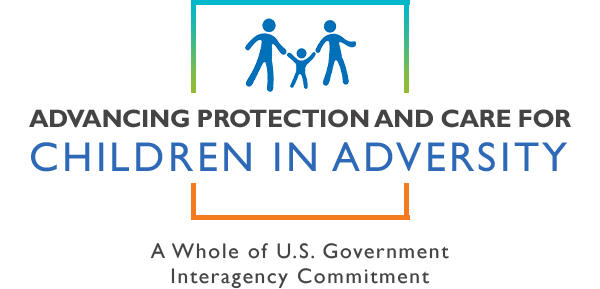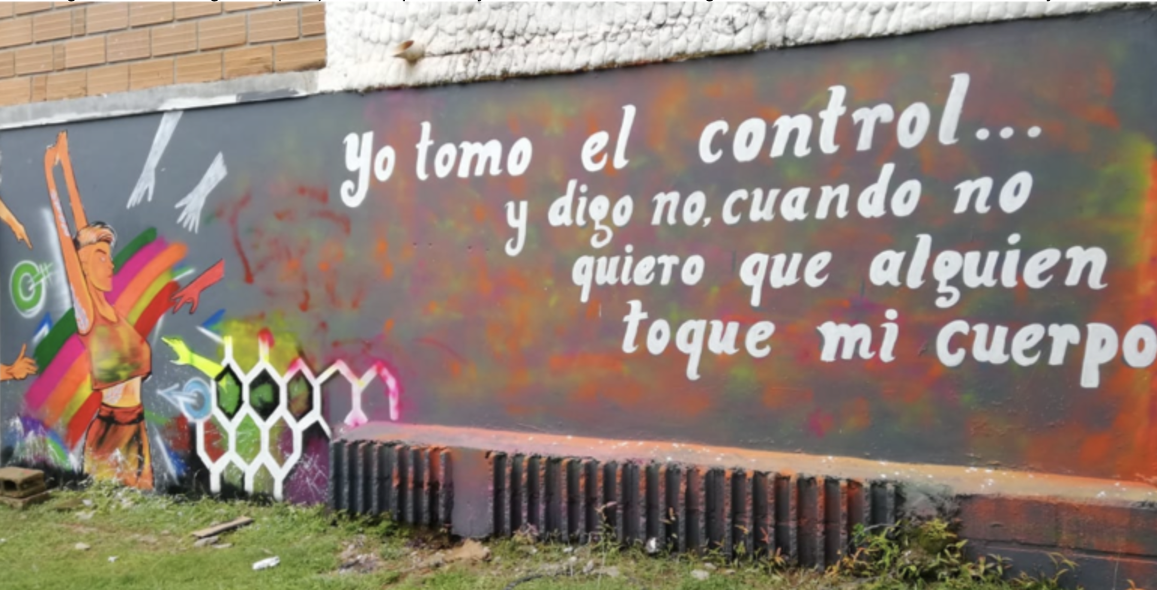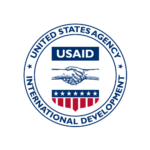Violence Against Children Survey (VACS) in COLOMBIA: A MODEL FOR IMPACT AND ACTION
October 25, 2021

“I take control and say no when I don’t want someone to touch my body.” Anti-Violence Mural in Buenaventura, Colombia (Photo credit: IOM)
“Ending violence against children is a worldwide human concern. It requires an urgent and
concrete response that implies a cooperative and multi-stakeholder approach.”
— Maria Juliana Ruiz, First Lady of Colombia
When the Violence Against Children Survey (VACS) for Colombia, published last year, revealed that two out of five of the country’s youth had experienced violence before the age of 18, two things became very clear: immediate action had to be taken, and the Government of Colombia could not tackle it alone. Thus began a well-coordinated international effort, personally supported by the First Lady of Colombia, Maria Juliana Ruiz, to bring together multiple agencies in developing a plan to protect Colombia’s children from further harm.

First Lady of Colombia Maria Juliana Ruiz speaking at the National Socialization event launch of the results of the Violence Against Children Survey (VACS) (Photo credit: IOM)
The VACS measures physical, emotional, and sexual violence against children and youth up to age 24. According to the U.S. Centers for Disease Control (CDC), which provides technical support to implement the survey, the first step in preventing violence globally is understanding how much it happens, where it occurs, and how it impacts the health and well-being of children and youth. It is a critical tool that has been applied in 21 countries to date, with additional countries planned, conducted via one-on-one confidential interviews by highly trained interviewers (called “enumerators” in Colombia), who travel across the country to speak with youth ages 13 – 24, even in the most remote areas.
Ultimately, the survey safely and anonymously gives voice to children who otherwise would not be heard, providing evidence-based data that governments can use to develop interventions tailored to the needs of children and youth. The Ministry of Health and Social Protection (MHSP) led the VACS effort in Colombia with funding primarily from USAID and supplemental funding from Together for Girls. The CDC provided technical assistance, and the International Organization of Migration (IOM) coordinated implementation.
Hiring a team of skilled interviewers who are native to the region and understand the culture is a critical part of the process. “In Colombia, enumerators must be carefully selected based on their personal experience with violence, as well as their professional experience,” said Alex Ordoñez, the VACS coordinator and point of contact for IOM in Colombia. “They are trained to build trust and to listen carefully for cues when a child is uncomfortable and maybe hiding the truth for fear of retribution.”
Some of the key data from the Colombia survey revealed:
- The percentage of 18- to 24-year-old youth who suffered sexual, physical, or psychological violence before the age of 18 was 40.8 percent in women and 42.1 percent in men;
- About half of those who experienced sexual violence in childhood (54 percent of girls and 48 percent of boys) never told anyone;
- 72 percent of sexual violence occurs in a home environment (of either the victim or the perpetrator);
- Overall, among youth ages 13 – 17 who experienced sexual violence in the previous 12 months, the most commonly reported perpetrator of the most recent incident was a friend, classmate, or neighbor (50.5 percent).
Though the survey results were daunting, what makes Colombia’s response noteworthy is the multi-stakeholder approach the government has embraced to develop a plan of action. The Colombia Institute for Family Welfare has built a coalition of technical advisors from several Colombian Government agencies; civil society and academic organizations; and international agencies including the CDC, USAID, UNICEF, Together for Girls, and others to assist in the process.
“This effort was purposely designed for everyone to sit down at the same table…with everyone supporting in some way or another.”
— Andres Villaveces, CDC
“In many countries, there is no such collaboration as a matter of practice,” said Andres Villaveces, the CDC lead scientist for the VACS in Latin America, and one of the key participants in Colombia’s VACS response. “This effort was purposely designed for everyone to sit down at the same table bearing in mind their own missions and, respecting that, sort of gives each institution a priority role on some activities, with everyone supporting in some way or another. The aim is to help the government eventually implement those interventions.
“We actually meet almost weekly or biweekly as a group,” he added, “and we have very transparent communication on who’s doing what and where we are. That has been possible because last year we actually drew up a work plan, a roadmap of activities with timelines assigned and with sort of different institutions leading different activities.”
The outcome of this very structured collaboration has been the development of not just one plan for addressing this issue, but 33 plans: one overarching national action plan and 32 sub-national action plans, one for each of the country’s departments (the equivalent of a state in the U.S.). In addition, the government has identified over 130 different interventions that are currently being piloted or implemented. Then, according to Dr. Villaveces, using methodological, contextual, institutional, and administrative criteria, they will select the best ones to scale up for support.
The team identified the three biggest priorities, which include the need to address norms and value changes, particularly around sexual violence; the need to increase or address work with parents; and the need to address interventions at the school level in education and life skills. The proposed interventions align with the U.S. Government Advancing Protection and Care for Children in Adversity (APCCA) strategic objective to promote, fund, and support the protection of children from violence, exploitation, abuse, and neglect by investing in preventative and responsive programming, and are based on guidelines provided by the INSPIRE strategy for the prevention of child maltreatment, promoted by the World Health Organization (WHO).

Protesting the recruitment of minors by illegal armed groups in Colombia
(Photo credit: IOM)
In addition to developing rigorous plans to respond to the VACS, there has been an ongoing grassroots social movement led by the youth themselves to raise awareness of the critical need to speak out against violence, particularly in regions that were not forthcoming in addressing reported incidents. Local artists are amplifying the voices of youth through music, dance, and artistic installations that reflect their desire for a life without violence.
“It’s up to all of us to change the situation.”
— Alex Ordonez, IOM
“Violence has been a common phenomenon for the youth of Colombia for far too long,” said Angie Fabiana Delgado, a performer with the hip-hop group Memoria Urbana. “Our goal is to get youth talking about these issues, not to hide from them.”
“We want our friends to know they are not alone in facing violence,” said the group’s director, Javier Martinez, who lost his brother to an illegal armed group in the country. He wants others to know there are paths they can take to escape violence. “Expressing themselves through the arts is another choice they can make. Violence does not have to be inevitable,” he said.

Activists Angie Fabiana Delgado (far left) and Javier Martinez (second from right) perform at an #EndViolence campaign event with their hip-hop group Memoria Urbana. Javier started the group after losing his brother to conflict and is one of the local leaders working toward change. (Photo credit: IOM)
These locally-led efforts demonstrate that communities are taking the initiative to address violence against children and youth. “It’s up to all of us to change the situation,” added Alex. “We can’t afford to wait for the government.”
Though that sentiment is shared by many, the First Lady of Colombia has championed this as a cause the government is committed to tackling.
In a speech at the Together to #EndViolence Summit Series in December, the First Lady outlined some of the specific steps the country has embraced in its plans to address these issues including:
● Introducing legislation to prohibit physical punishment of minors,
● Designing a gender-based violence information system, and
● Committing to a loving parenting and play strategy, among many others.
She then issued a passionate call-to-action to other First Ladies around the world to “establish a national partnership based on zero-tolerance against any form of violence against children.” Colombia has committed to the Sustainable Development Goal of ending all violence against children by 2030, which she described as an “admittedly ambitious target,” but one they intend to reach by working collaboratively and consistently to keep the needs of Colombian youth front and center.
USAID/Colombia Mission Director Larry Sacks echoed that sentiment. “USAID/Colombia and our counterparts have used the Violence Against Children and Youth Surveys to drive data-informed policy and programs to effectively tackle the root causes of violence against children and youth, as well as help us strategically contribute to youth’s positive development. USAID/Colombia will continue to partner with the Government of Colombia to protect and empower at-risk children and youth,” he said.
“The Colombian model is a model we want to show,” Dr. Villaveces remarked. “We want to extract the useful elements that work so that we can replicate this elsewhere. Part of the communication with the Colombian government is to rather frequently encourage them to, ‘make it work because we’re going to show you off if it works.’ Our collective goal is to do everything we can to ensure that it does.”
To learn more about the VACS approach, read our interview with VACS Enumerator, Manuel B. here.







